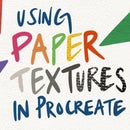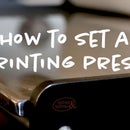Introduction: Easy Stencil Screen Printing
Creating images with stencils is one of my favourite screen printing methods. Many screen printing tutorials cover complex photographic emulsion methods, which can be quite intimidating, and I'm here to show you that by using basic materials you can quickly make engaging images. In this tutorial, we use tape stencils, paper stencils and screen filler stencils to create a set of graphic two-colour prints. You can use these same methods to create single colour prints on either fabric or paper.
Supplies
Screenprinting Screen (my screen is 43T mesh, you generally don't need a super fine screen for these methods)
Screenprinting Squeegee
Screenprinting Ink
Masking tape
Scrap paper for stencils
Screen filler (I used Speedball Art brand screen filler)
Spoon
Scissors
Paint brush
Paper for printing (fabric printing using these techniques is also possible)
Rags and access to water for cleaning screen and squeegee
Step 1: Prepare Your Paper
The first step before beginning any printmaking project is to prepare your paper. I used scraps of paper from a previous project, but if you have a large sheet of paper you can cut or tear it down to size. Preparing the printing paper in advance will allow you to plan the size of your print more easily.
Step 2: Map Out Your Design
My image is a simple one based on a satellite image. I drew it out roughly on a piece of paper, then held it up to a window and traced the reverse image on the back. I used this as a guide when making my stencils.
Step 3: Making a Tape and Paper Stencil
Masking tape and paper work very well as stencils for screen printing. I began by taping my design to the inside of the screen, then flipping it over to make the stencil.
The image section of the stencil was made by cutting strips of tape to shape with a pair of scissors, and placing them on the screen in the areas that I wanted to remain white when printing. When I'd applied tape over all the lines, I flipped the screen back over and removed the design guide. There were a few more places that I wanted to block out, so I turned the screen over again and applied more tape in those areas.
To block out the areas surrounding my design, I cut up some scrap junk mail and taped it roughly onto the screen, reinforcing the edges of the design with extra tape.
Step 4: Printing the First Colour
Before I began printing, I taped out a quick registration guide on my desk marking where to place the paper and screen so that the images would align when printing.
Each print takes two passes of ink with your squeegee. Spoon out a line of ink above your image and draw it down lightly (without pressing hard) to fill your screen with ink. Take a second pass, pushing the ink down with the edge of your squeegee held at a 45º angle to transfer the ink in the screen to your paper (or fabric).
Remove your print, then pick up any ink remaining at the bottom of the screen with your squeegee and tap it back above the design. Print the rest of your edition, adding more ink as you need to. The first print will usually be a bit rough, and successive prints will be more even.
Leave your prints to dry spread out somewhere safe while you clean up and prepare the screen for a second colour.
Step 5: Cleaning the Screen
When you've finished printing your edition, scrape off any excess ink and return it to a jar for reuse, then simply pull away the tape and paper to remove the stencil.
Wipe away as much of the ink in your screen as you can with a damp cloth or sponge, then rinse out the screen in a sink (a bath with a hand held shower head is useful for this) and leave it somewhere warm to dry.
Clean your squeegee carefully with a rag or paper towel.
Step 6: Painting a Stencil Using Screen Filler
Another way to create a stencil print is to paint screen filler directly onto your screen (I used Speedball Art brand screen filler, and this will need to be cleaned from my screen later with a compatible cleaner). This will give you an organic, painterly effect. As with the paper stencil, I used my initial design as a guide, tracing the lettering from my design with a chinagraph pencil (you don't need to do this, but it was useful for my particular design), then I painted the screen filler and applied a paper stencil onto the flat side of the screen (the side that makes contact with the table. Leave the screen filler to dry completely and tape up any other open areas of your screen with scrap paper before doing a test print.
Step 7: Print Your Second Colour
Beginning with a test print, print your second colour using the same printing methods as the first run. Check your print when done to see if you need to make any adjustments or additions to your screen filler stencil. There were a few areas on my first print where I hadn't applied quite enough screen filler, so I cleaned the ink away from design area carefully with a damp cloth and touched up the screen with screen filler.
When the screen filler was dry, I finished printing my edition.
Step 8: Finish Your Prints
After leaving the prints to dry for several hours, sign and title your edition and complete any finishing touches you need to. My prints were intended as labels for a batch of wine, so I cut around the edges and glued them to my bottles.
And that's it! Fun, graphic and interesting screen prints made with basic materials. The video clearly shows the techniques for designing, printing and cleaning, which can be difficult to show using only images, so be sure to give it a watch.

Participated in the
Anything Goes Contest













